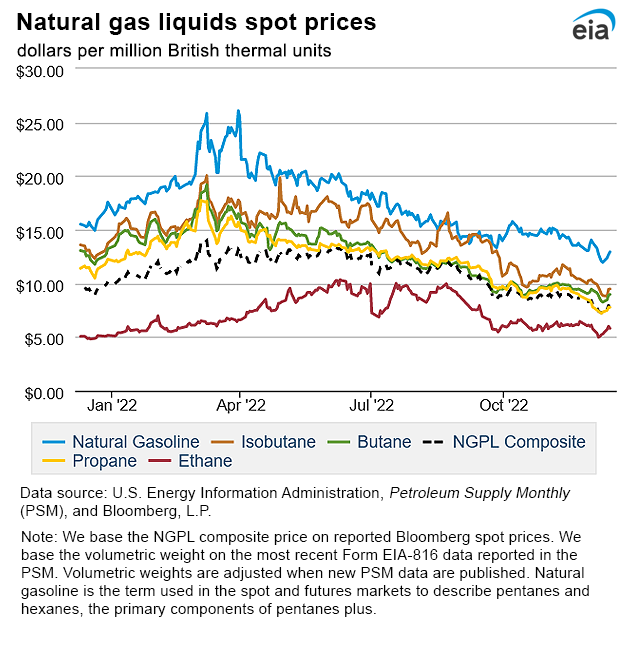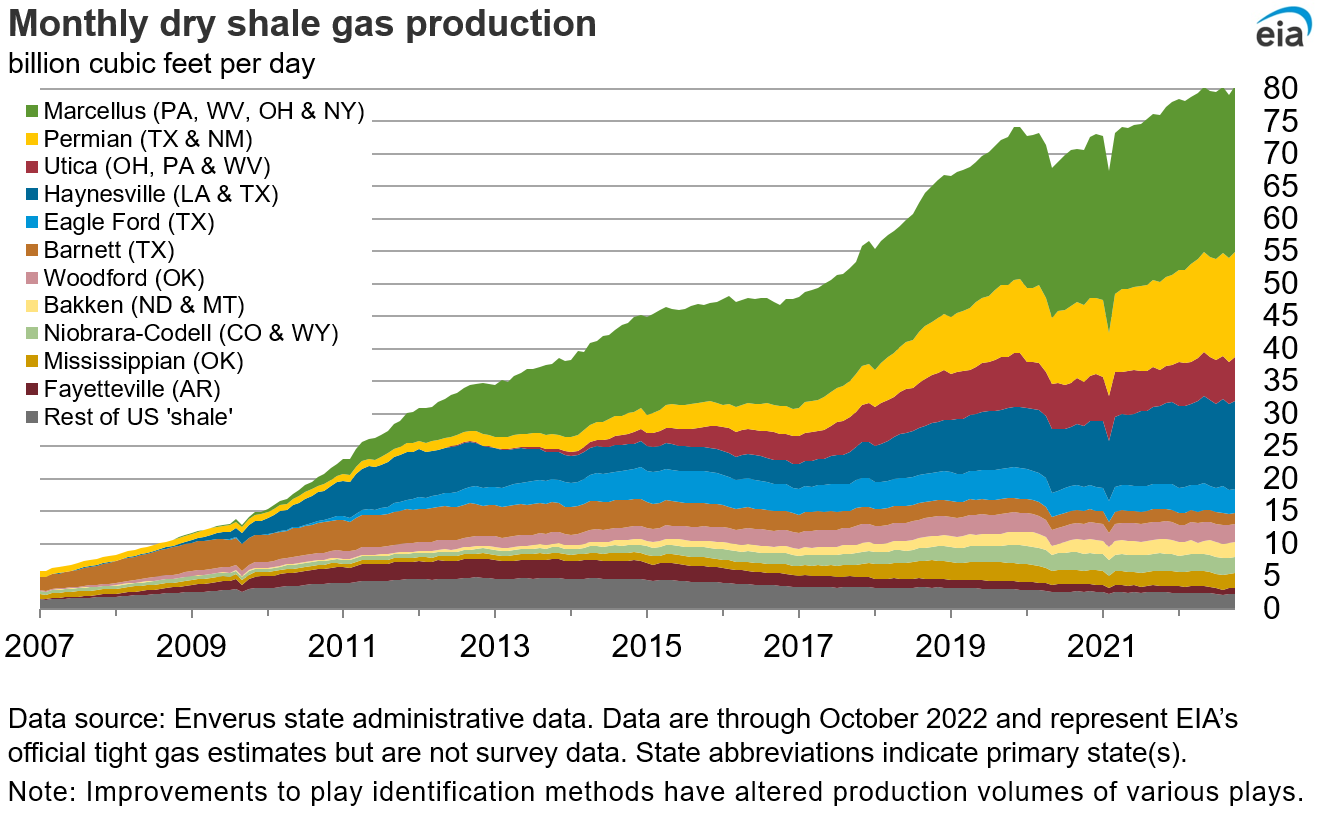In the News:
U.S. industrial natural gas consumption expected to increase more than 3% in 2022
We forecast that U.S. industrial natural gas consumption will increase by 3% in 2022, based on the December Short-Term Energy Outlook (STEO), after increasing by 2% in 2021. Industrial use of natural gas is set to average more than 23 billion cubic feet per day in 2022, above the pre-pandemic peak in 2019. Industrial natural gas consumption will account for about 26% of total U.S. natural gas consumption in 2022.
Industrial sector natural gas consumption reflects less seasonal variability than natural gas consumption in the residential, commercial, and electricity sectors. Winter is the peak season for industrial natural gas usage in the United States because of dual space-heat and process requirements.
Much of the 2022 increase comes from the chemicals subsector and the other manufacturing subsector. The chemicals subsector, the largest natural gas consumer in the industrial sector, accounts for 29% of the total. This subsector uses natural gas to create heat, generate electricity, and serve as a feedstock to produce methanol, fertilizer, and hydrogen. Natural gas used to produce fertilizer is one of the largest chemical feedstocks
Another major use for natural gas as feedstock is for the production of methanol (CH3OH), a natural gas-derived substance that’s widely used as a precursor for chemical derivatives. In recent years, the United States added significant methanol production capacity, particularly in Texas and Louisiana. U.S. methanol production capacity grew in both 2021 and 2022 and increased throughput accounted for some of the increased industrial consumption.
Crude oil refineries are also an important natural gas consumer, accounting for about 14% of all industrial natural gas consumption in 2021. U.S. natural gas consumption by refineries grew consistently from 2015 through 2021, driven by Gulf Coast refineries.
We expect a 4% decrease in natural gas consumption in the industrial sector in 2023, driven by a decline in the manufacturing production index (especially non-metallic minerals and paper and pulp industries) as well as high natural gas prices. Natural gas usage for fertilizer feedstock remained relatively flat in 2021, and we expect it will continue to remain flat in 2022 and 2023.
Market Highlights:
(For the week ending Wednesday, December 14, 2022)Prices
- Henry Hub spot price: The Henry Hub spot price rose $2.07 from $4.53 per million British thermal units (MMBtu) last Wednesday to $6.60/MMBtu yesterday.
- Henry Hub futures prices: The price of the January 2023 NYMEX contract increased 70.7 cents, from $5.723/MMBtu last Wednesday to $6.430/MMBtu yesterday. The price of the 12-month strip averaging January 2023 through December 2023 futures contracts climbed 45.8 cents to $5.490/MMBtu.
- Select regional spot prices: Natural gas spot prices increased at all locations this report week (Wednesday, December 7, to Wednesday, December 14), with spikes in some intra-week prices in the West reaching nearly $50/MMBtu. Week-over-week price increases at major pricing hubs ranged from $1.36/MMBtu at Eastern Gas South in Western Pennsylvania to $5.55/MMBtu at the Opal Hub in southwest Wyoming.
- Prices in the West remained at elevated levels this report week, well above Henry Hub and other major U.S. markets, with large intra-week moves, including spikes to multi-year highs at some price hubs. The price at Sumas on the Canada-Washington border rose $4.03 from $21.19/MMBtu last Wednesday to $25.22/MMBtu yesterday, after reaching a weekly high of $46.80 on Tuesday. The price at Malin, Oregon, the northern delivery point into the PG&E service territory, rose $2.55 from $20.65/MMBtu last Wednesday to $23.20/MMBtu yesterday. The price at Opal Hub in southwest Wyoming rose $5.55 from $20.82/MMBtu last Wednesday to $26.37/MMBtu yesterday. The Opal market is a key source of natural gas for the West Coast. The price at PG&E Citygate in Northern California rose $2.33, up from $20.96/MMBtu last Wednesday to $23.29/MMBtu yesterday, after rising to $48.17/MMBtu on Tuesday, the highest price reported since December 2000. The price at SoCal Citygate in Southern California increased $4.02 from $22.87/MMBtu last Wednesday to $26.89/MMBtu yesterday, after reaching $49.67/MMBtu on Tuesday. Below-normal temperatures persisted in the West this week, bringing heavy snow to parts of the region. In the Seattle City Area temperatures averaged 41°F this week, 1°F below normal, which resulted in 6 more heating degree days (HDD) than normal. Temperatures in the Sacramento Area averaged 47°F this week, which resulted in 128 HDDs, 5 more HDDs than normal. In Southern California temperatures fell further below normal; temperatures in the Riverside Area averaged 48°F, 6°F below normal, leading to 41 more HDDs than normal. On Monday, temperatures in the Riverside Area averaged 45°F, the lowest value over the week, and 10°F lower than normal. Consumption of natural gas in all sectors in California and the Desert Southwest regions combined increased by 10%, or 1.0 billion cubic feet per day (Bcf/d) week over week, according to data from PointLogic. SoCalGas, the main natural gas utility in Southern California, reported a material decline in natural gas inventories, which are now down more than 20% since November 1, and about 19 Bcf below levels at the same time last year. In the Pacific Northwest, total consumption declined by 8%, or 0.3 Bcf/d week over week, following last week’s 0.3 Bcf/d week-over-week increase, as temperatures in the Pacific Northwest moderated slightly compared with last week’s well-below-normal temperatures.
- In the Northeast, at the Algonquin Citygate, which serves Boston-area consumers, the price increased $5.27 from $4.90/MMBtu last Wednesday to $10.17/MMBtu yesterday. At the Transcontinental Pipeline Zone 6 trading point for New York City, the price increased $3.82 from $4.46/MMBtu last Wednesday to $8.28/MMBtu yesterday. Temperatures in the Boston Area averaged 35°F this report week, 9°F lower than last week and 2°F below normal, leading to 14 more HDDs than is normal for this time of year. In the New York-Central Park Area, temperatures averaged 37°F, resulting in 18 more HDDs than normal. Consumption of natural gas in all sectors in the Northeast region increased by 13%, or 2.9 Bcf/d week over week, according to data from PointLogic.
- Prices in West Texas rose this week. The price at the Waha Hub, which is located near Permian Basin production activities, increased by $3.58, from $0.38/MMBtu last Wednesday to $3.96/MMBtu yesterday. The Waha Hub traded $2.64 below the Henry Hub price yesterday, compared with last Wednesday when it traded $4.15 below the Henry Hub price. Capacity on the Kinder Morgan-operated Permian Highway Pipeline (PHP) has been reduced from its nameplate capacity of 2.1 Bcf/d by multiple maintenance events, reducing southbound natural gas deliveries from the Permian Basin to the Gulf Coast. At the start of this report week, the pipeline was restricted to 1.7 Bcf/d capacity, and after returning to normal on Saturday, it had a second maintenance event on Tuesday that resulted in capacity being reduced to 1.7 Bcf/d while maintenance continues through Friday. Starting Saturday, December 17, PHP will operate at a reduced capacity of 1.8 Bcf/d until further notice as the operator performs repairs on one of the units at the Coyanosa Compressor Station.
- International futures prices: International natural gas futures price movements were mixed this report week. According to Bloomberg Finance, L.P., weekly average front-month futures prices for liquefied natural gas (LNG) cargoes in East Asia increased $0.48 to a weekly average of $33.46/MMBtu. Natural gas futures for delivery at the Title Transfer Facility (TTF) in the Netherlands, the most liquid natural gas market in Europe, decreased $0.50 to a weekly average of $42.46/MMBtu.
- Natural gas plant liquids (NGPL) prices: The natural gas plant liquids composite price at Mont Belvieu, Texas fell by 19 cents/MMBtu, averaging $7.58/MMBtu for the week ending December 14. Ethane prices rose 3%, while natural gas prices at the Houston Ship Channel rose 11%, narrowing the ethane premium to natural gas by 28%. Ethylene spot prices remained unchanged, narrowing the ethylene to ethane premium by 4%. Propane prices fell 2%, while the weekly average price of Brent crude oil fell 4%, resulting in a 7% decrease in the propane discount relative to crude oil. Normal butane and isobutane prices fell 5% and 8%, respectively, and natural gasoline prices fell 6%.
Daily spot prices by region are available on the EIA website.
Supply and Demand
- Supply: According to data from PointLogic, the average total supply of natural gas rose by 0.2% (0.2 Bcf/d) compared with the previous report week. Dry natural gas production grew by 0.1% (0.1 Bcf/d), and average net imports from Canada increased by 2.7% (0.1 Bcf/d) from last week.
- Demand: Total U.S. consumption of natural gas rose by 2.6% (2.4 Bcf/d) compared with the previous report week, according to data from PointLogic. Natural gas consumed for power generation climbed by 1.2% (0.4 Bcf/d) week over week. Industrial sector consumption remained unchanged, averaging 24.6 Bcf/d, while consumption increased by 5.6% (2.0 Bcf/d) in the residential and commercial sectors combined. Natural gas exports to Mexico decreased 6.8% (0.4 Bcf/d). Natural gas deliveries to U.S. LNG export facilities (LNG pipeline receipts) averaged 12.4 Bcf/d, or 0.5 Bcf/d higher than last week.
Liquefied Natural Gas (LNG)
- Pipeline receipts: Overall natural gas deliveries to U.S. LNG export terminals increased by 0.5 Bcf/d week over week to average 12.4 Bcf/d this report week, according to data from PointLogic. Natural gas deliveries to LNG export terminals in South Louisiana increased by 0.4 Bcf/d to 8.9 Bcf/d, and natural gas deliveries to LNG export terminals in South Texas increased by 0.1 Bcf/d to 2.3 Bcf/d. Natural gas deliveries to all other terminals were essentially unchanged.
- Vessels departing U.S. ports: Twenty-three LNG vessels (nine from Sabine Pass, five from Cameron, four from Corpus Christi, three from Calcasieu Pass, and two from Cove Point) with a combined LNG-carrying capacity of 86 Bcf departed the United States between December 8 and December 14, according to shipping data provided by Bloomberg Finance, L.P.
- LNG facilities: Commercial operations at Freeport LNG have yet to restart. The Federal Energy Regulatory Commission (FERC) made an engineering information request to Freeport LNG on December 12, stating preconditions for the restart of operations.
Rig Count
- According to Baker Hughes, for the week ending Tuesday, December 6, the natural gas rig count decreased by 2 to 153; two rigs were dropped in unidentified basins. The number of oil-directed rigs also fell by 2 to 625, the first week-over-week decline in oil-directed rigs since October 28. One oil-directed rig was added in the Barnett, one was added in the Eagle Ford, and two rigs were added in the Granite Wash. One rig each was dropped in the Ardmore Woodford, Cana Woodford, and Mississippian, and three were dropped in unidentified basins. The total rig count, which includes 2 miscellaneous rigs, decreased by 4, and it now stands at 780.
Storage
- Net withdrawals from underground storage totaled 50 Bcf for the week ending December 9, compared with the five-year (2017–2021) average net withdrawals of 93 Bcf and last year's net withdrawals of 83 Bcf during the same week. Working natural gas stocks totaled 3,412 Bcf, which is 15 Bcf, or less than 1%, lower than the five-year average and 18 Bcf (1%) lower than last year at this time.
- According to The Desk survey of natural gas analysts, estimates of the weekly net change to working natural gas stocks ranged from net withdrawals of 34 Bcf to 62 Bcf, with a median estimate of 47 Bcf.
Other Market Drivers
- On Friday, December 9, Energy Transfer, operator of the ETC Tiger Pipeline, LLC, issued a critical notice of capacity reduction on the pipeline during station maintenance. The Tiger Pipeline begins in the Haynesville production region in northern Louisiana and ends near Carthage, Texas, a major pipeline and storage hub. Deliveries of natural gas east of the Bienville Compressor Station have been reduced from 2.4 Bcf/d to 1.8 Bcf/d from December 14 through December 16. The maintenance will affect westbound flows of natural gas out of the Haynesville Basin as well as connected southbound pipelines that feed LNG and industrial facility demand along the Gulf Coast. Yesterday, Energy Transfer received FERC approval to place in service its modifications to Line CP, which runs parallel to the Tiger Pipeline, and the newly-built Gulf Run Pipeline, which will transport natural gas from Line CP south to Gulf Coast markets. Gulf Run Transmission reports no nominations on the systems as of this morning.
See also:
Top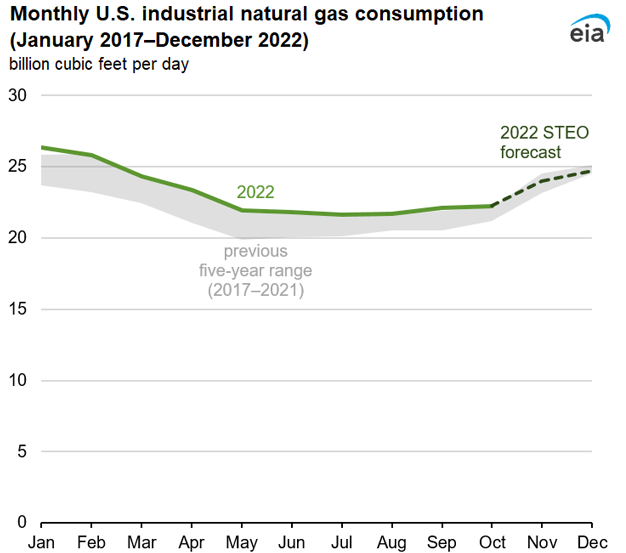
Data source: U.S. Energy Information Administration, Natural Gas Monthly, November 2022; Short-Term Energy Outlook (STEO), December 2022
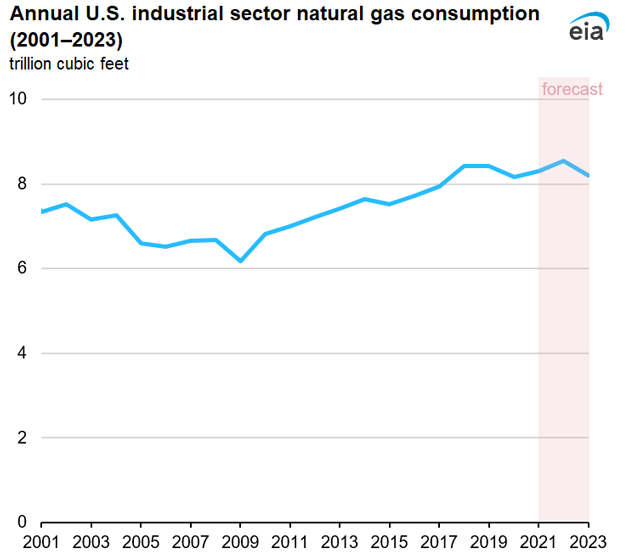
Data source: U.S. Energy Information Administration, Natural Gas Monthly, November 2022; Short-Term Energy Outlook (STEO), December 2022
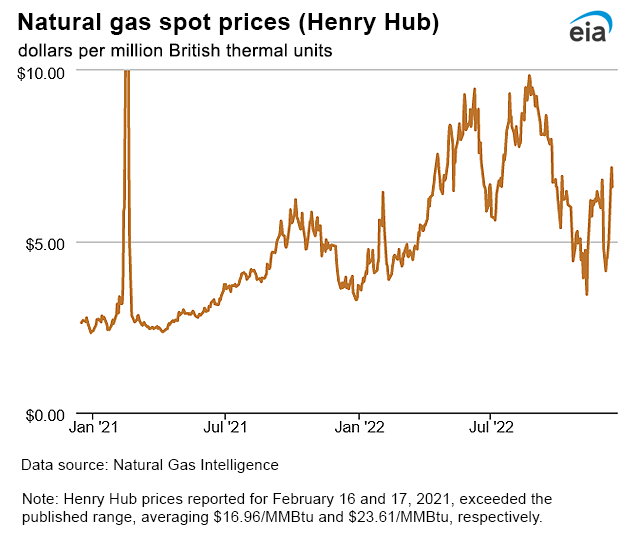
| Spot Prices ($/MMBtu) | Thu, 08-Dec |
Fri, 09-Dec |
Mon, 12-Dec |
Tue, 13-Dec |
Wed, 14-Dec |
|---|---|---|---|---|---|
| Henry Hub |
4.77 |
5.00 |
6.72 |
7.16 |
6.60 |
| New York |
5.05 |
5.44 |
9.49 |
11.69 |
8.28 |
| Chicago |
4.70 |
4.92 |
5.72 |
6.02 |
5.71 |
| Cal. Comp. Avg.* |
31.20 |
45.26 |
40.19 |
48.06 |
23.86 |
| Futures ($/MMBtu) | |||||
| January contract | 5.962 |
6.245 |
6.587 |
6.935 |
6.430 |
| February contract |
5.820 |
6.082 |
6.416 |
6.733 |
6.220 |
| Data source: Natural Gas Intelligence and CME Group as compiled by Bloomberg, L.P. *Avg. of NGI's reported prices for: Malin, PG&E Citygate, and Southern California Border Avg. |
|||||
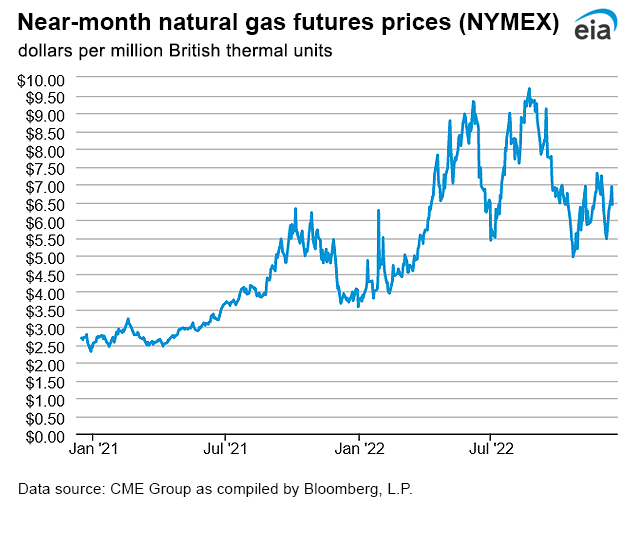
| U.S. natural gas supply - Gas Week: (12/8/22 - 12/14/22) | |||
|---|---|---|---|
Average daily values (billion cubic feet) |
|||
this week |
last week |
last year |
|
| Marketed production | 112.5 |
112.4 |
108.4 |
| Dry production | 100.2 |
100.1 |
96.6 |
| Net Canada imports | 5.3 |
5.2 |
5.0 |
| LNG pipeline deliveries | 0.1 |
0.1 |
0.1 |
| Total supply | 105.6 |
105.4 |
101.7 |
|
Data source: PointLogic | |||
| U.S. natural gas consumption - Gas Week: (12/8/22 - 12/14/22) | |||
|---|---|---|---|
Average daily values (billion cubic feet) |
|||
this week |
last week |
last year |
|
| U.S. consumption | 93.2 |
90.8 |
90.5 |
| Power | 31.1 |
30.7 |
29.9 |
| Industrial | 24.6 |
24.6 |
24.8 |
| Residential/commercial | 37.5 |
35.5 |
35.8 |
| Mexico exports | 5.2 |
5.5 |
5.6 |
| Pipeline fuel use/losses | 7.4 |
7.4 |
7.2 |
| LNG pipeline receipts | 12.4 |
11.8 |
11.9 |
| Total demand | 118.2 |
115.6 |
115.3 |
|
Data source: PointLogic | |||
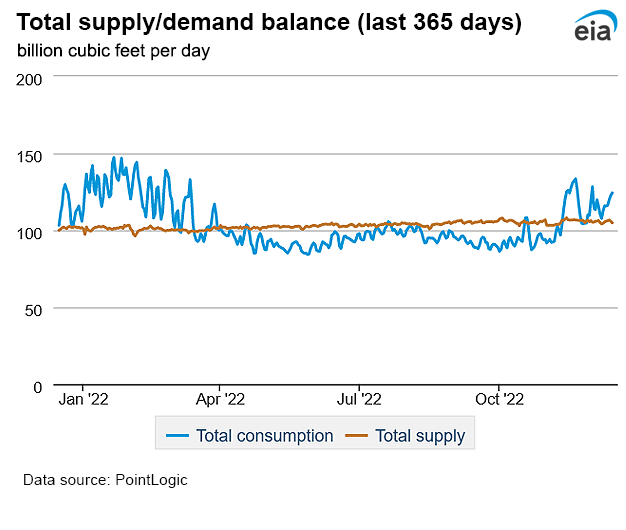
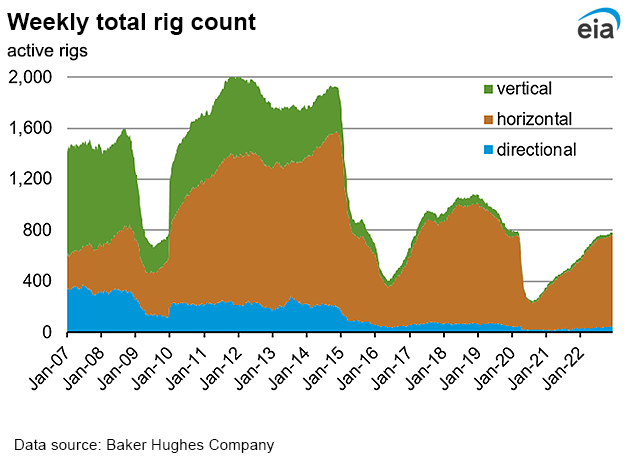
| Rigs | |||
|---|---|---|---|
Tue, December 06, 2022 |
Change from |
||
last week |
last year |
||
| Oil rigs | 625 |
-0.3% |
32.7% |
| Natural gas rigs | 153 |
-1.3% |
45.7% |
| Note: Excludes any miscellaneous rigs | |||
| Rig numbers by type | |||
|---|---|---|---|
Tue, December 06, 2022 |
Change from |
||
last week |
last year |
||
| Vertical | 26 |
4.0% |
8.3% |
| Horizontal | 708 |
-0.4% |
35.9% |
| Directional | 46 |
-4.2% |
48.4% |
| Data source: Baker Hughes Company | |||
| Working gas in underground storage | ||||
|---|---|---|---|---|
Stocks billion cubic feet (Bcf) |
||||
| Region | 2022-12-09 |
2022-12-02 |
change |
|
| East | 822 |
834 |
-12 |
|
| Midwest | 1,002 |
1,028 |
-26 |
|
| Mountain | 186 |
193 |
-7 |
|
| Pacific | 203 |
217 |
-14 |
|
| South Central | 1,199 |
1,191 |
8 |
|
| Total | 3,412 |
3,462 |
-50 |
|
| Data source: U.S. Energy Information Administration Form EIA-912, Weekly Underground Natural Gas Storage Report | ||||
| Working gas in underground storage | |||||
|---|---|---|---|---|---|
Historical comparisons |
|||||
Year ago (12/9/21) |
5-year average (2017-2021) |
||||
| Region | Stocks (Bcf) |
% change |
Stocks (Bcf) |
% change |
|
| East | 822 |
0.0 |
827 |
-0.6 |
|
| Midwest | 987 |
1.5 |
990 |
1.2 |
|
| Mountain | 200 |
-7.0 |
197 |
-5.6 |
|
| Pacific | 262 |
-22.5 |
276 |
-26.4 |
|
| South Central | 1,160 |
3.4 |
1,136 |
5.5 |
|
| Total | 3,430 |
-0.5 |
3,427 |
-0.4 |
|
| Data source: U.S. Energy Information Administration Form EIA-912, Weekly Underground Natural Gas Storage Report | |||||
| Temperature – heating & cooling degree days (week ending Dec 08) | ||||||||
|---|---|---|---|---|---|---|---|---|
HDDs |
CDDs |
|||||||
| Region | Current total |
Deviation from normal |
Deviation from last year |
Current total |
Deviation from normal |
Deviation from last year |
||
| New England | 173 |
-38 |
-17 |
0 |
0 |
0 |
||
| Middle Atlantic | 171 |
-30 |
-4 |
0 |
0 |
0 |
||
| E N Central | 213 |
-17 |
6 |
0 |
0 |
0 |
||
| W N Central | 259 |
2 |
51 |
0 |
0 |
0 |
||
| South Atlantic | 116 |
-25 |
14 |
12 |
3 |
3 |
||
| E S Central | 95 |
-49 |
3 |
4 |
3 |
3 |
||
| W S Central | 53 |
-53 |
3 |
16 |
13 |
1 |
||
| Mountain | 205 |
-9 |
52 |
0 |
0 |
-1 |
||
| Pacific | 137 |
24 |
47 |
0 |
-1 |
0 |
||
| United States | 164 |
-16 |
19 |
4 |
2 |
1 |
||
|
Data source: National Oceanic and Atmospheric Administration Note: HDDs=heating degree days; CDDs=cooling degree days | ||||||||
Average temperature (°F)
7-day mean ending Dec 08, 2022
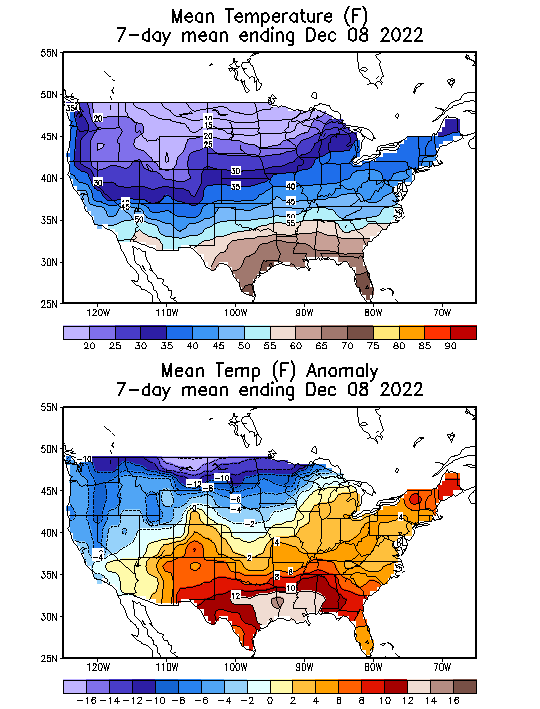
Data source: National Oceanic and Atmospheric Administration
Deviation between average and normal temperature (°F)
7-day mean ending Dec 08, 2022

Data source: National Oceanic and Atmospheric Administration

